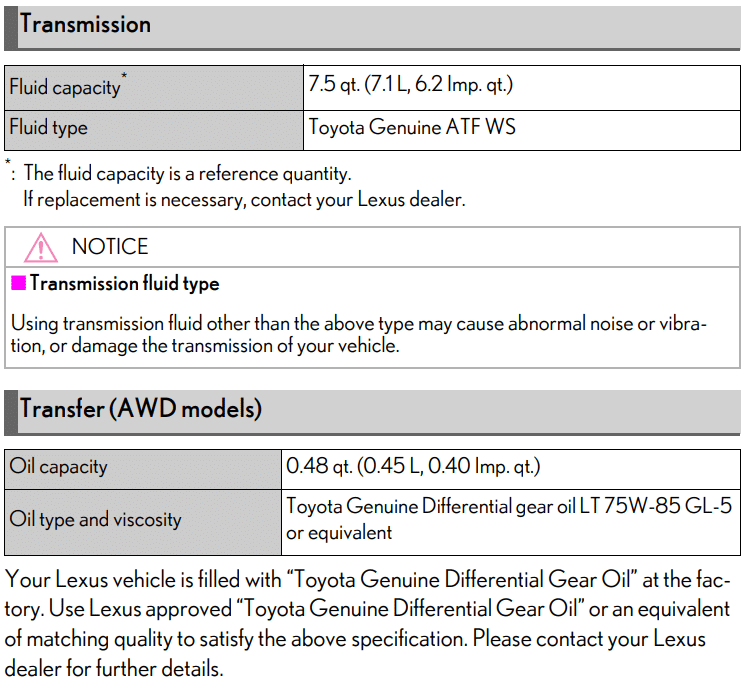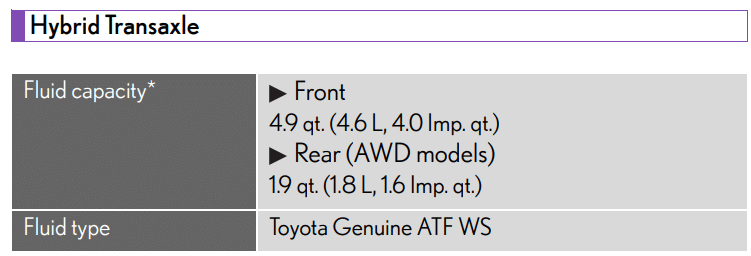The transmission is a vital component of any vehicle, acting as the bridge between the engine and the wheels, ensuring that power is transmitted efficiently to move the vehicle. At the heart of this intricate system is the transmission fluid, a medium that not only lubricates, but also facilitates the smooth shifting of gears, cools the transmission components, and cleans the system from any contaminants.
Using the correct transmission fluid is paramount for several reasons:
- Optimal Performance: The right fluid is formulated to provide the best viscosity or “thickness” that ensures smooth gear shifts and efficient power transfer. Using an incorrect fluid can lead to suboptimal performance and even potential damage.
- Protection Against Wear: Transmission components are constantly in motion and under high pressure. The correct fluid provides a protective layer that reduces wear and tear, extending the life of these components.
- Heat Management: Transmissions generate heat. The right fluid has properties that dissipate this heat, ensuring that the transmission doesn’t overheat, which can lead to failures.
- Contaminant Removal: Over time, tiny metal shavings and other contaminants can accumulate in the transmission. The correct fluid will contain detergents designed to clean and carry away these contaminants, preventing buildup and ensuring smooth operation.
- Cost Efficiency: In the long run, using the right transmission fluid can save significant amounts of money. An incorrect or low-quality fluid can lead to premature wear, inefficient performance, and eventual breakdowns, all of which can result in costly repairs.
In the context of the Lexus RX, a vehicle renowned for its luxury and performance, ensuring the use of the correct transmission fluid is even more critical. This guide aims to provide clarity on the right fluid types and capacities across various RX generations, ensuring that owners can make informed decisions and keep their vehicles running at peak performance.

2023-Present Lexus RX Transmission Fluid Capacity And Transmission Fluid Type
The transmission fluid capacity ranges between 7.3 to 7.6 quarts for a full drain and refill. Lexus, like many other manufacturers, will have a specific type or specification for transmission fluid that’s optimized for their vehicles.

Commonly, for previous Lexus models, Toyota’s World Standard (WS) ATF-WS automatic transmission fluid is used.
| Gearbox | Fluid capacity | Fluid type |
|---|---|---|
| Lexus RX350 AWD 8-speed automatic | Total fill: 7.5 quarts (7.1 liters) | ATF-WS |
| Lexus RX350 FWD 8-speed automatic | Total fill: 7.5 quarts (7.1 liters) | ATF-WS |
| Lexus RX350H Q610 automatic | Total fill: 1.8 quarts (1.7 liters) | ATF-WS |
| Lexus RX350H P810 automatic | Total fill: 4.6 quarts (4.35 liters) | ATF-WS |
2016-2022 Lexus RX Transmission Fluid Capacity And Transmission Fluid Type
The Lexus RX AL20 from 2016 to 2022, being a part of the luxury line-up of Toyota, is engineered with precision and is expected to have very specific requirements for fluids to ensure smooth operation.

For many luxury SUVs in this category, the total transmission fluid capacity usually ranges between 5 to 7.2 quarts. But this is a general range.
| Gearbox | Fluid capacity | Fluid type |
|---|---|---|
| Lexus RX350 FWD 8-speed automatic | Total fill: 7.2 quarts (6.8 liters) Initial fill: 3.2 quarts (3 liters) | ATF-WS |
| Lexus RX350 AWD 8-speed automatic | Total fill: 7.2 quarts (6.8 liters) Initial fill: 3.2 quarts (3 liters) | ATF-WS |
| Lexus RX350L FWD 8-speed automatic | Total fill: 7.2 quarts (6.8 liters) Initial fill: 3.2 quarts (3 liters) | ATF-WS |
| Lexus RX350L AWD 8-speed automatic | Total fill: 7.2 quarts (6.8 liters) Initial fill: 3.2 quarts (3 liters) | ATF-WS |
| Lexus RX450H Q610 automatic | Total fill: 1.9 quarts (1.8 liters) | ATF-WS |
| Lexus RX450H P313 automatic | Total fill: 5.1 quarts (4.8 liters) | ATF-WS |
For this generation of Lexus vehicles, the Toyota’s World Standard (WS) automatic transmission fluid is typically recommended. This fluid has been engineered to offer the right viscosity, protective qualities, and performance metrics to ensure the smooth and effective operation of the Lexus transmission system.
2010-2015 Lexus RX Transmission Fluid Capacity And Transmission Fluid Type
Before the facelift, the 3rd generation of Lexus RX introduced several advancements. The facelifted version of the 3rd generation Lexus RX continued to epitomize the brand’s commitment to luxury and performance. Proper care, especially in the area of transmission fluid, is vital for the longevity and optimal functioning of the vehicle.
| Gearbox | Fluid capacity | Fluid type |
|---|---|---|
| Lexus RX350 6-speed automatic | Total fill: 7.1 quarts (6.7 liters) Initial fill: 3 quarts (2.8 liters) | ATF-WS |
| Lexus RX450H CVT | Total fill: 4.9 quarts (4.6 liters) | ATF-WS |
| Lexus RX350 8-speed automatic | Total fill: 7.2 quarts (6.8 liters) Initial fill: 3.2 quarts (3 liters) | ATF-WS |

The transmission fluid capacity typically sits in the range of 6 to 10 quarts for a full drain and refill. It’s worth noting that during a routine fluid change, the total capacity might not be utilized due to some fluid retention in various components. For exact details, always consult the service manual specific to these model years or contact a Lexus dealership.
The recommended fluid for these years also generally aligns with Toyota’s World Standard (WS) automatic transmission fluid. It is crafted to provide optimal lubrication, protection, and overall performance to the transmission system of the Lexus RX.
2004-2009 Lexus RX Transmission Fluid Capacity And Transmission Fluid Type
The early versions of the 2nd generation Lexus RX set a benchmark in the luxury SUV market, blending performance with comfort. Maintenance is paramount to preserve its legacy.
For Lexus RX models between 2004 and 2009, the transmission fluid capacities and types differ based on the specific model and its features. Here’s a concise breakdown:
| Gearbox | Fluid capacity | Fluid type |
|---|---|---|
| Lexus RX350 automatic | Drain and refill: 3.7 qt. (3.5 L, 3.1 lmp.qt.) Total fill: 9.3 qt. (8.8 L) | ATF WS |
| Lexus RX400H CVT | Towing package: 4.1 qt. (3.9 L) Without towing package: 3.9 qt. (3.7 L) | ATF WS |
| Lexus RX330 automatic | Drain and refill: 3.7 qt. (3.5 L, 3.1 lmp.qt.) Total fill: 9.3 qt. (8.8 L) | T-IV |
Note: “Drain and Refill” is the amount of fluid that typically comes out during a standard drain and fill procedure, whereas “Total Fill” is the overall fluid capacity of the transmission system if it were to be completely emptied (e.g., during a rebuild). When doing routine maintenance, you’ll typically be dealing with the “Drain and Refill” amount.
1999-2003 Lexus RX Transmission Fluid Capacity And Transmission Fluid Type
For Lexus RX models between 1999 and 2003, the transmission fluid capacities and types are particular to the specific transmission variant in the vehicle. Here’s a concise breakdown for these models:
Lexus RX300 with 4-speed U140E Automatic Transmission
- Drain and Refill Capacity: 3.7 qt. (3.5 L, 3.1 lmp.qt.)
- Total Fill Capacity: 8.8 qt. (8.3 L)
- Transmission Fluid Type: T-IV
Lexus RX300 with 4-speed U140F Automatic Transmission
- Drain and Refill Capacity: 4.1 qt. (3.9 L)
- Total Fill Capacity: 9.7 qt. (9.2 L)
- Transmission Fluid Type: T-IV
| Gearbox | Fluid capacity | Fluid type |
|---|---|---|
| Lexus RX300 4-speed U140E automatic | Drain and refill: 3.7 qt. (3.5 L, 3.1 lmp.qt.) Total fill: 8.8 qt. (8.3 L) | T-IV |
| Lexus RX300 4-speed U140F automatic | Drain and refill: 4.1 qt. (3.9 L) Total fill: 9.7 qt. (9.2 L) | T-IV |
As with any maintenance task, it’s essential to use the recommended fluid type to ensure optimal performance and longevity of the transmission system. The “Drain and Refill” capacity indicates the amount of fluid typically drained during a standard service, while the “Total Fill” capacity refers to the system’s full fluid capacity if completely emptied.
Always check the fluid level with the vehicle level and the transmission at operating temperature when refilling.
For these early models, Toyota Type T-IV (T4) automatic transmission fluid was the commonly recommended choice. This fluid meets the necessary specifications to ensure optimal performance, longevity, and protection of the RX’s transmission components.
Symptoms of Low or Contaminated Transmission Fluid
Transmission fluid plays a vital role in ensuring the smooth operation of your vehicle’s transmission. Its primary functions are to lubricate, cool, and transmit drive from the engine to the transmission. If the fluid is low, old, or contaminated, it can lead to a variety of issues. Here are some common signs that your transmission fluid may need checking or changing:
- Slipping Gears:
When the transmission fluid is low or degraded, it might not provide the necessary hydraulic pressure to keep gears engaged. This can result in the transmission slipping out of gear, causing a loss in acceleration or an unexpected change in the power delivered to the wheels. - Hard or Erratic Shifts:
Low or dirty transmission fluid can lead to rough gear changes, where shifts are noticeably hard or jarring. Alternatively, the transmission might shift erratically, changing gears at inappropriate times. - Delayed Gear Engagement:
If you notice a delay between shifting the gear lever and the gear actually engaging, especially when shifting from ‘park’ to ‘drive’ or ‘reverse,’ it could be due to insufficient or contaminated fluid. - Unusual Noises:
A transmission running on low or dirty fluid can produce whining, humming, clunking, or even grinding noises. These noises might be especially noticeable in neutral. - Overheating:
Transmission fluid helps cool the transmission. If it’s low or has lost its cooling properties due to age or contamination, the transmission can overheat, which can cause further damage. - Transmission Warning Light:
Many modern vehicles have sensors to monitor the quality and level of the transmission fluid. If there’s an issue, the transmission or check engine light might illuminate on your dashboard. - Cloudy or Dark Fluid:
Healthy transmission fluid is typically a clear reddish-pink. If you check the fluid and it appears dark, brown, or has a burnt smell, it’s a sign that it’s old or contaminated and needs to be replaced. - Evidence of Contamination:
Metal shavings, dirt, or other foreign particles in the fluid indicate contamination. This can accelerate wear and tear on the transmission’s internal components. - Poor Vehicle Performance:
Low or contaminated transmission fluid can lead to decreased acceleration, poor throttle response, and a general sluggishness in the vehicle’s performance. - Fluid Leaks:
If you notice red or brownish puddles or spots under your vehicle, it’s a sign of a transmission fluid leak. Leaks not only mean the fluid level is dropping but also that contaminants can enter the system.
It’s essential to attend to these symptoms promptly. Ignoring problems related to transmission fluid can result in severe damage to the transmission, leading to expensive repairs or replacements.
Regularly checking and changing the fluid as per the manufacturer’s recommendation can prolong the lifespan of the transmission and ensure smooth vehicle performance.
Transmission Fluid Change Frequency
The interval at which you should change your transmission fluid largely depends on your vehicle’s make and model, the type of transmission fluid used, and your driving conditions. Here are some general guidelines to consider:
- Manufacturer’s Recommendation:
- Always start by consulting your vehicle’s owner’s manual. Most manufacturers provide specific intervals for transmission fluid replacement based on their testing and design considerations.
- Typically, for many vehicles, the recommended interval ranges between 30,000 to 60,000 miles for regular driving conditions. However, some modern vehicles with advanced synthetic transmission fluids may have longer intervals, even up to 100,000 miles or more.
- Type of Transmission Fluid:
- Conventional Fluid: Older vehicles or those not designed for synthetic fluids might require changes every 30,000 to 45,000 miles.
- Synthetic Fluid: Vehicles that use synthetic transmission fluid can often go longer between changes, sometimes up to 60,000 to 100,000 miles.
- Driving Conditions:
Certain conditions can significantly reduce the lifespan of your transmission fluid:- Heavy Towing or Hauling: Carrying heavy loads regularly can heat the transmission fluid, causing it to degrade faster. Consider changing the fluid every 15,000 to 30,000 miles in these conditions.
- Frequent Stop-and-Go Traffic: If you’re often driving in heavy traffic conditions, the constant shifting and idling can put more strain on the transmission and its fluid. In such cases, consider shorter intervals, like every 30,000 miles.
- Mountainous or Hilly Terrain: Regularly driving in hilly areas can cause the transmission to work harder, leading to faster fluid degradation.
- Dusty or Sandy Environments: If you live in an area with a lot of dust or sand, these particles can contaminate the transmission fluid more quickly.
- Regular Checks:
- Even if you’re not hitting the recommended mileage, it’s a good practice to check the transmission fluid at least once a year or every 10,000 to 15,000 miles. This allows you to inspect the fluid’s color, consistency, and smell. If the fluid is dark, smells burnt, or has particles in it, it may be time for a change.
- Some vehicles come equipped with transmission fluid life monitors that will alert you when a change is needed based on the condition of the fluid.
- Automatic vs. Manual Transmission:
- Automatic: Generally, automatic transmissions are more finicky about fluid condition. Regular changes can prevent issues like slipping gears and rough shifts.
- Manual: Manual transmissions can be a bit more forgiving, but it’s still essential to replace the fluid at the recommended intervals to ensure smooth gear operation and prevent wear.
Cost Estimates for Changing Transmission Fluid
The cost of changing transmission fluid can vary widely based on factors like your vehicle’s make and model, your geographical location, the type of fluid required, and whether you’re opting for service at a dealership or doing it yourself. Below are some general cost estimates:
- At a Dealership:
- Cost: The cost at a dealership for a transmission fluid change can range between $150 to $300. This price generally includes labor, the fluid, and any associated parts or tools needed (like a new gasket or filter if applicable). Dealerships might charge a premium compared to independent garages due to their specialized knowledge of brand-specific vehicles and the use of OEM (Original Equipment Manufacturer) parts.
- Benefits: A dealership will have specialized tools and expertise specific to your vehicle model. They’ll also use OEM parts and fluids recommended by the vehicle manufacturer.
- Doing It Yourself (DIY):
- Cost: If you decide to change the transmission fluid yourself, the primary expense will be the fluid and any necessary parts. Fluid can range from $20 to $100 or more based on the quantity and type (synthetic fluids generally cost more). You might also need to purchase a new filter, gasket, or pan (if not reusable), which could add another $15 to $50 to the overall cost. Therefore, a DIY fluid change could cost you anywhere from $35 to $150, or even slightly more, depending on your requirements.
- Benefits: DIY can be more cost-effective. Additionally, performing the change yourself gives you an intimate understanding of your vehicle’s condition.
- Potential Cost Savings Over Time:
- Regular Maintenance Benefits: Changing the transmission fluid at recommended intervals can save you from expensive transmission repairs or replacements in the long run. A well-maintained transmission can extend the life of your vehicle and provide a smoother driving experience.
- Cost Avoidance: A transmission rebuild or replacement can cost anywhere from $1,500 to $4,000 or more based on the vehicle and location. By investing in regular maintenance, including fluid changes, you can potentially avoid these hefty expenses.
- Improved Fuel Efficiency: A transmission in good working order can also provide better fuel efficiency, saving you money at the pump over time.
FAQs about Transmission Fluid in Lexus RX
- How often should I change the transmission fluid in my Lexus RX?
Answer: Typically, for many Lexus RX models, the recommended interval is between 30,000 to 60,000 miles for regular driving conditions. However, always refer to your vehicle’s owner’s manual for the most accurate recommendation. - Can I use any brand of transmission fluid for my Lexus RX?
Answer: It’s advisable to use the transmission fluid recommended by Lexus, usually Toyota Type T-IV (T4) or its equivalent for many models. However, always check your owner’s manual or consult with a Lexus dealership. - How can I check the level and quality of the transmission fluid?
Answer: Most Lexus RX models come with a transmission dipstick. The fluid should be checked with the engine warm and running, and the vehicle on a level surface. Clean fluid is typically a clear reddish-pink, while dark or burnt-smelling fluid indicates a need for a change. - Is it necessary to change the transmission filter every time I change the fluid?
Answer: Not necessarily. However, it’s often recommended to replace the filter during every second or third fluid change to ensure optimal performance. Consult your service manual or dealership for specifics. - Can I mix synthetic and conventional transmission fluids?
Answer: It’s generally not advisable to mix different types of fluids, as this can alter their properties and potentially affect transmission performance. If switching types, it’s best to do a complete fluid flush.
References and Resources
- Official Lexus Service Manuals:
For the most accurate and detailed information, always consult the official Lexus service manuals. Here, you can find specifications and recommendations for your specific Lexus RX model. - Lexus Owners’ Club Forum:
The Lexus Owners’ Club Forum is a valuable resource where you can connect with other Lexus RX owners, share experiences, and get advice on various maintenance topics. - ClubLexus:
Another trusted online community is ClubLexus. This forum covers a broad range of topics and is an excellent platform for getting insights from other Lexus enthusiasts. - Toyota Nation Forum:
Given that Lexus is Toyota’s luxury vehicle division, the Toyota Nation Forum can also be a valuable resource for general maintenance information and experiences related to the Lexus RX.
Remember, while online forums and communities offer valuable insights from real-world users, always consult official sources or professionals when making decisions about your vehicle’s maintenance.
















